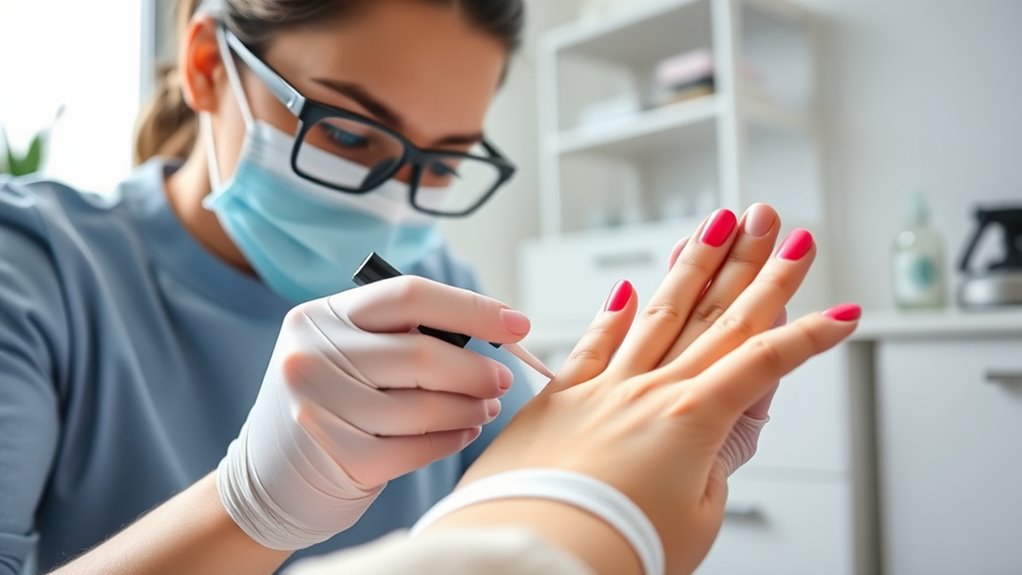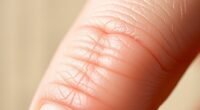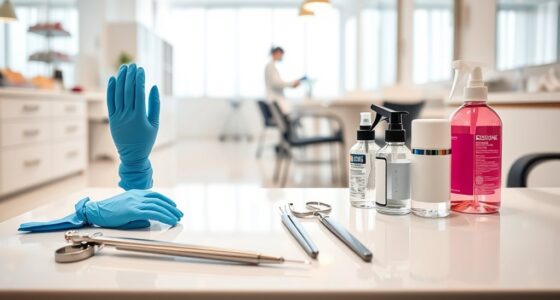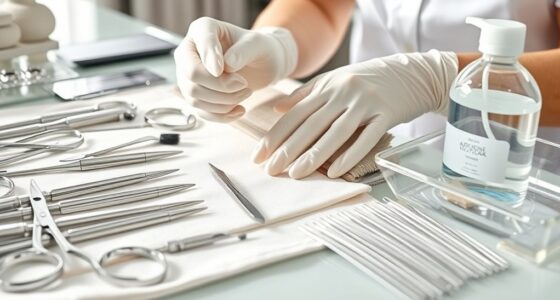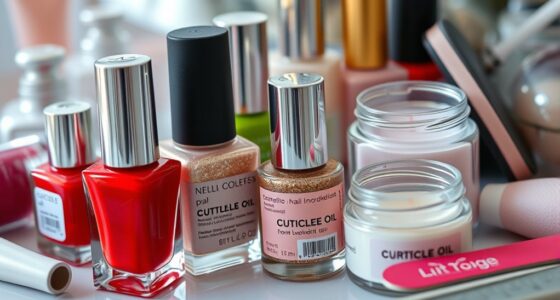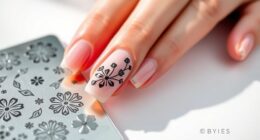To prevent allergies to nail products, choose hypoallergenic and “3-free” or “5-free” options, and always verify labels for known allergens like formaldehyde or toluene. Conduct patch tests 48 hours before applications and guarantee proper ventilation in your workspace. Use PPE correctly and educate clients on ingredient sensitivities. If you want to learn how to recognize and manage reactions quickly, keep exploring these safety tips and best practices.
Key Takeaways
- Choose “3-free” or “5-free” hypoallergenic nail products and read ingredient labels carefully.
- Conduct patch tests 48 hours before application to identify potential allergic reactions.
- Use proper PPE and ensure effective ventilation to minimize inhalation of fumes and allergens.
- Educate clients and technicians on allergy symptoms, triggers, and safe application practices.
- Promptly stop use, rinse affected areas, and seek medical help for any signs of allergic reactions.
Understanding Common Nail Product Allergens
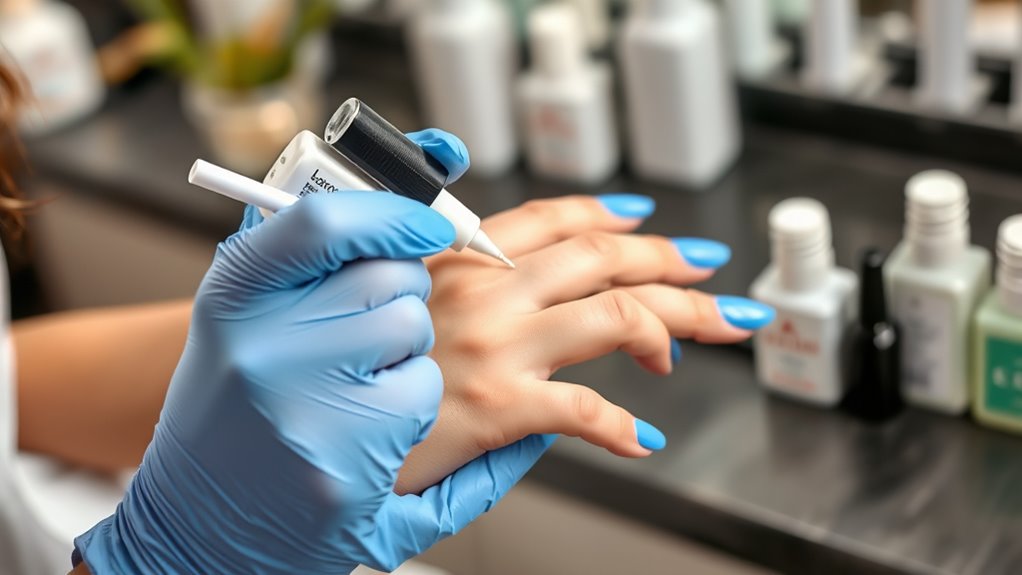
Many people develop allergic reactions to certain ingredients in nail products, making it important to know what to watch out for. Nail polish ingredients often contain common allergens like formaldehyde, toluene, and dibutyl phthalate. Being aware of these ingredients helps you identify potential risks. To reduce chances of an allergic response, practice allergen avoidance strategies such as choosing products labeled “3-free” or “5-free,” which exclude common irritants. Always read ingredient lists carefully and opt for hypoallergenic options when possible. If you or your clients have sensitive skin, consider patch testing new products before full application. Staying informed about nail polish ingredients and practicing allergen avoidance strategies is essential in preventing allergic reactions and maintaining healthy nails. Incorporating knowledge of sound healing science and other holistic approaches can also promote overall well-being and stress relief, which may contribute to healthier skin and nail health.
Recognizing Symptoms of Nail Product Allergies
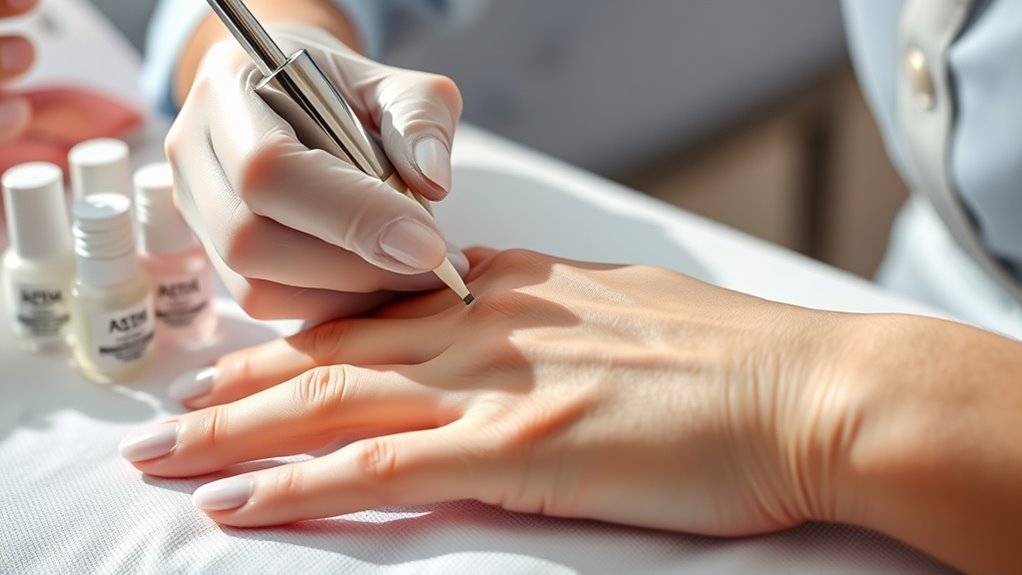
Have you noticed redness, itching, or swelling around your nails after a manicure? These are common signs of a nail product allergy. You might also experience blistering or a rash near the cuticles. Pay attention if your skin becomes tender or inflamed after exposure to nail art or other salon treatments. Sometimes, symptoms can appear hours or even days after your appointment. Recognizing these signs early helps prevent more severe reactions. Keep in mind that salon decor, like scented candles or certain cleaning products, can sometimes trigger or worsen allergies. If you notice persistent symptoms, it’s crucial to inform your technician and seek medical advice. Being aware of these symptoms ensures you can take prompt action and protect your skin from further irritation. Additionally, understanding color accuracy in related products can help you choose safer options for your nails.
Choosing Hypoallergenic Nail Products

To reduce the risk of allergic reactions, choosing hypoallergenic nail products is essential. Look for brands that clearly label their items as hypoallergenic, free from common irritants like formaldehyde, toluene, and DBP. Consider natural remedies and alternative therapies, such as nail oils or serums with soothing ingredients, to support healthier nails and skin. These products often contain fewer chemicals and are less likely to trigger allergies. Always read ingredient lists carefully and opt for products tested by dermatologists. Educate clients about the benefits of hypoallergenic options and encourage them to perform patch tests before full application. Additionally, awareness of Halloween celebrations around the world can inspire creative, themed nail designs that are fun and culturally respectful. By selecting safer, hypoallergenic products, you minimize allergy risks while still providing beautiful, durable nails.
Proper Ventilation and Workspace Safety Measures
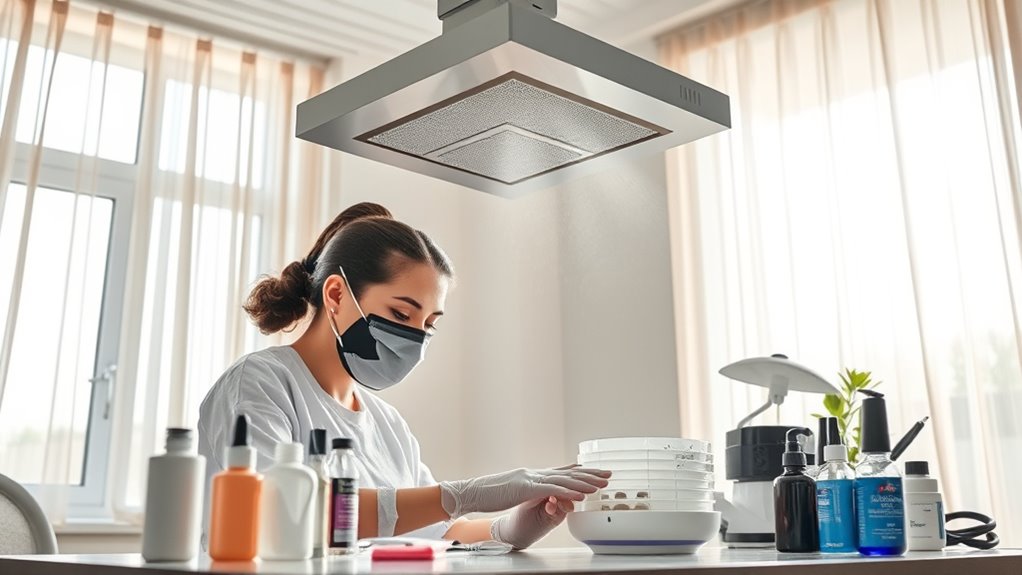
Proper ventilation is crucial in creating a safe workspace for both nail technicians and clients, as it helps disperse harmful fumes and airborne particles generated during procedures. Good air quality reduces the risk of allergic reactions and respiratory issues. Ensure your workspace includes an efficient exhaust system or local ventilation, like a vent fan or air purifier, to keep fumes from lingering. Additionally, prioritize workspace ergonomics by arranging tools and products within easy reach to minimize strain and promote comfort. Keep windows open when possible to improve airflow and supplement mechanical ventilation. Regularly maintain ventilation equipment to guarantee ideal performance. By focusing on proper ventilation and ergonomic setup, you create a safer environment that minimizes allergen exposure and enhances overall air quality for everyone. Incorporating technological solutions like air quality monitors can further help identify and address airborne contaminants proactively.
Conducting Patch Tests Before Full Application
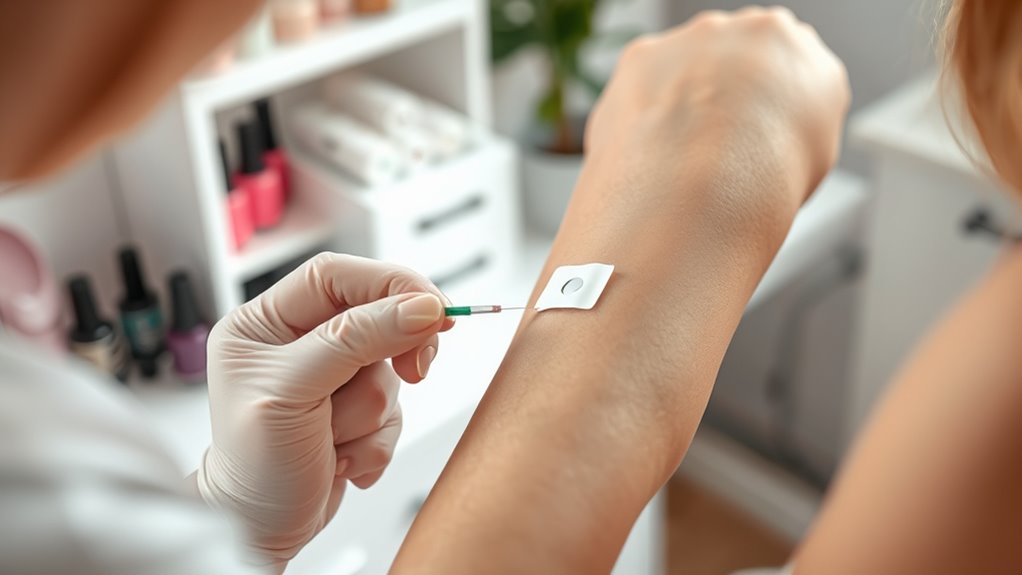
Before applying nail products fully, you should perform a patch test to check for reactions. Pay attention to the timing and placement of the test, and watch for signs of skin sensitivity. Learning how to interpret the results helps you identify potential allergies before they become a problem. Incorporating proper testing procedures can further ensure safety and minimize adverse reactions.
Timing and Placement
Conducting a patch test is a essential step in preventing allergic reactions to nail products. Proper application timing guarantees you give the skin enough time to react, typically 48 hours, before proceeding with full treatments. During placement, choose an area with sensitive skin, like behind the ear or on the inner wrist, to monitor for signs of irritation. Use precise placement strategies to avoid applying products to broken or damaged skin, which can increase sensitivity. By carefully timing your patch tests and selecting the right spots, you minimize the risk of allergic responses. This approach helps you identify potential issues early, ensuring safer, more comfortable experiences for both clients and technicians. Proper timing and placement are critical for effective allergy prevention.
Skin Sensitivity Indicators
Skin sensitivity indicators are vital signs that can reveal how your skin will react to nail products. Before applying full treatments, conducting a patch test helps identify potential irritation signs. If your skin barrier is compromised or weakened, you’re more prone to adverse reactions. Look for redness, itching, swelling, or burning at the test site, which are clear irritation signs. These indicators suggest that your skin may react negatively to certain ingredients. Paying close attention to these signs allows you to prevent more severe allergic responses later. Always perform patch tests on a small area and monitor closely. Recognizing these sensitivity indicators early helps protect both clients and yourself from unnecessary discomfort and allergic reactions during nail procedures. Enhanced natural language processing can also help interpret subtle skin responses and improve early detection of reactions.
Interpreting Patch Results
Interpreting patch test results is vital to determine if your skin can safely tolerate a nail product. When reviewing the results, look for signs of an allergic reaction, such as redness, swelling, or blistering at the testing site. Accurate interpretation helps in allergy diagnosis and prevents future reactions. Recognizing the emotional support that loved ones provide can also help in managing allergic reactions and the stress they may cause. Properly interpreting patch results ensures you identify allergies early and avoid full product application on sensitive skin. This step is essential to safeguard your health and maintain safe, allergen-free nail services.
Using Personal Protective Equipment Effectively
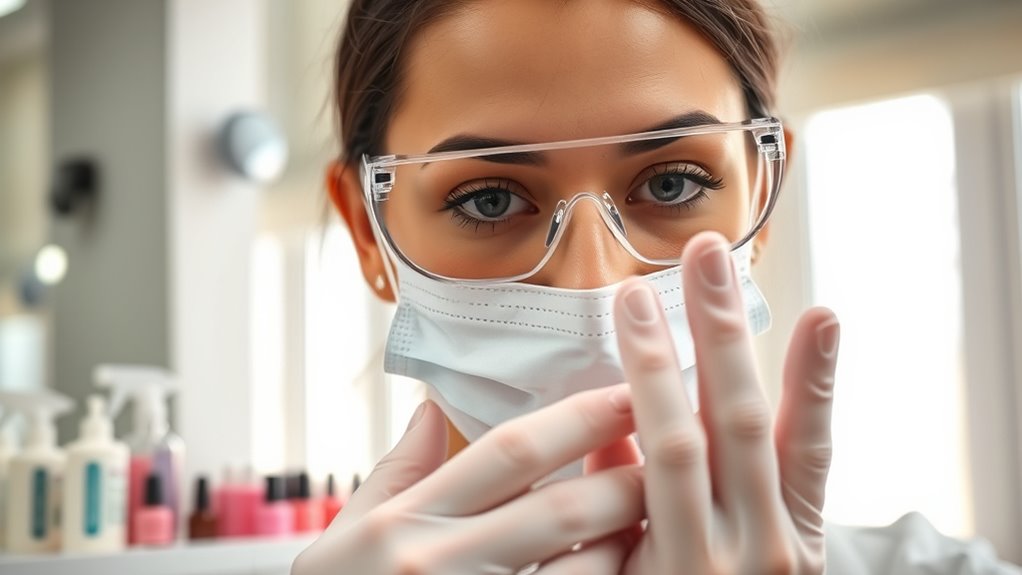
To effectively prevent nail product allergies, you need to use personal protective equipment (PPE) correctly every time you work with these products. Proper glove selection is essential; choose gloves made from materials that provide a barrier against allergens and ensure they fit snugly without tearing. Always inspect gloves for signs of damage before use. Mask fitting is equally important; make sure your mask covers your nose and mouth securely without gaps, creating a tight seal. This minimizes inhalation of fumes and particles that can trigger allergic reactions. Adjust your PPE as needed during procedures to maintain protection. Consistent, correct use of PPE reduces your risk of developing allergies and keeps both you and your clients safe. Additionally, understanding the dog breed-specific names can help in creating a friendly and personalized environment, especially when working with clients who are dog owners.
Educating Clients and Technicians on Allergy Prevention
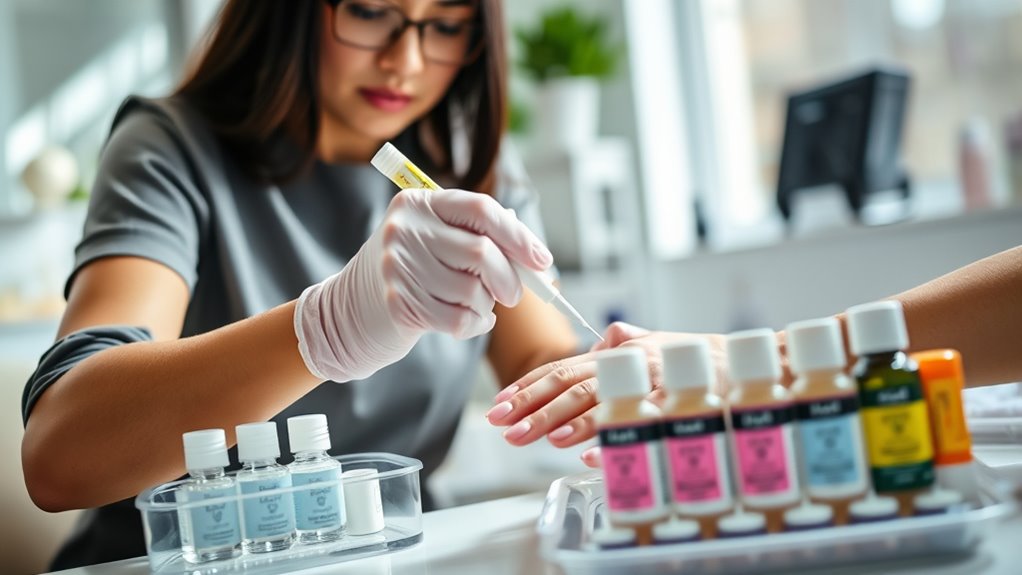
You need to teach clients and technicians how to spot allergic symptoms early so they can seek prompt treatment. Encourage safe product use by informing them about ingredient sensitivities and proper application techniques. When everyone understands allergy prevention, you reduce the risk of severe reactions and improve overall safety. Promoting awareness of inspirational quotes about fatherhood can foster a caring attitude and shared responsibility in maintaining safety standards.
Recognize Allergic Symptoms Early
Early recognition of allergic symptoms is crucial for preventing more serious reactions and minimizing discomfort. Being alert to signs of an allergic response helps you act quickly and avoid worsening symptoms. Common symptoms include redness, itching, swelling, or blistering around the nails or skin. Recognizing these early indicators allows you to identify potential allergy triggers and understand immune responses. To stay vigilant, watch for:
- Persistent redness or swelling after product application
- Itching or burning sensations on the skin
- Blisters or rash development near treated areas
- Understanding how sound design techniques can be used to create alerts or notifications for health monitoring systems could also be beneficial in certain contexts.
Promote Safe Product Use
Educating clients and technicians about allergy prevention is essential for minimizing the risk of adverse reactions. Emphasize the importance of reading product labeling carefully, as it provides vital information about ingredients. Encourage both parties to look for products that prioritize ingredient transparency, making it easier to identify potential allergens. Explain that understanding labels helps in selecting safer options and avoiding known triggers. Remind clients to ask technicians about ingredient lists if they’re unsure, and urge technicians to stay informed about product formulations. Promoting safe product use involves being proactive in reviewing labels, asking questions, and choosing products with clear, transparent ingredient information. This approach fosters a safer environment and reduces allergy risks for everyone involved.
Managing Reactions and When to Seek Medical Advice
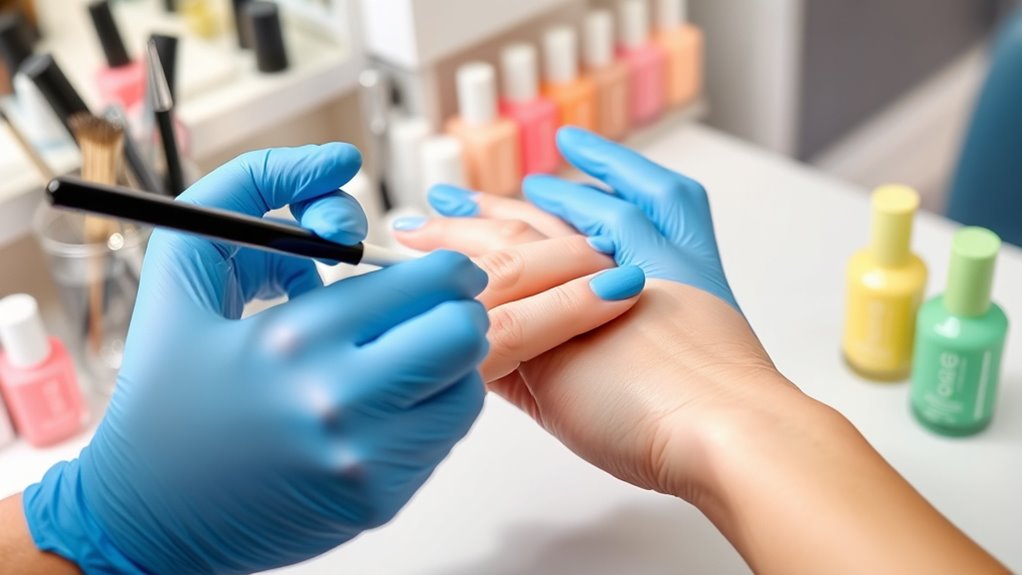
When you notice signs of an allergic reaction to nail products, prompt action can prevent the situation from worsening. Reaction management is vital, so stop using the product immediately and rinse the area with water. You should seek medical consultation if symptoms are severe or persistent, such as swelling, difficulty breathing, or intense itching. To handle reactions effectively, consider these steps:
- Apply a cool compress to reduce swelling and soothe irritation
- Use over-the-counter antihistamines or corticosteroid creams if advised
- Keep track of your symptoms and product ingredients for future reference
If symptoms escalate or don’t improve quickly, don’t hesitate to see a healthcare professional. Early reaction management and timely medical consultation can keep reactions from developing into serious health issues.
Frequently Asked Questions
How Often Should Clients Undergo Patch Testing for Allergies?
You should have clients undergo patch testing every 6 to 12 months, depending on their allergy history and exposure. Regular patch testing frequency helps catch any new allergies early. Encourage an allergy re-evaluation if clients experience irritation or symptoms between tests. This proactive approach guarantees their safety and helps identify potential sensitivities, allowing you to modify products or techniques accordingly. Consistent testing is key to maintaining healthy, allergy-free nails.
Are There Specific Brands Known for Fewer Allergenic Ingredients?
You might wonder if certain brands are safer, and the answer is yes. Some hypoallergenic brands offer allergen-free formulations, reducing the risk of reactions. These brands often use fewer or no harsh chemicals, making them a better choice for sensitive skin. Always check labels for allergen information and opt for reputable, dermatologically tested options to minimize allergy risks. This proactive approach helps protect both your clients and your reputation.
Can Allergy Symptoms Develop After Multiple Years of Use?
Yes, allergy symptoms can develop after years of use due to long-term sensitivity. You might experience delayed reactions, even if you’ve previously used nail products without issues. Continuous exposure can cause your immune system to become more reactive over time. To protect yourself, pay attention to any new or worsening symptoms, and consider switching products or taking breaks to reduce the risk of developing allergies later on.
What Are Alternative Nail Products for Highly Sensitive Individuals?
If you’re highly sensitive, consider switching to hypoallergenic options made with natural ingredients to reduce allergy risks. Look for nail products labeled “free from formaldehyde, toluene, and DBP,” and choose brands that focus on gentle, botanical formulas. These alternatives help protect your skin and nails, minimizing irritation. Always do a patch test first and consult with your tech about ingredients to find the safest, most comfortable nail care for you.
How Can Technicians Minimize Allergen Exposure During Removal?
Did you know that improper removal can cause allergic reactions in up to 20% of clients? To minimize allergen exposure during removal, always wear protective gloves and work in well-ventilated areas. Use high-quality ventilation systems to reduce airborne particles, and carefully follow safe removal procedures. This not only safeguards your clients but also guarantees a safer, healthier environment for you. Stay vigilant and prioritize safety during every removal process.
Conclusion
By staying informed and taking proactive steps, you can create a safer, more comfortable experience for everyone. Your attention to detail and care can gently prevent discomfort, allowing your clients and yourself to enjoy the beauty of nails without worry. Embrace these practices as a way to nurture trust and confidence, turning each appointment into a moment of genuine pampering. Ultimately, your dedication helps craft a space where beauty and well-being flourish together.
